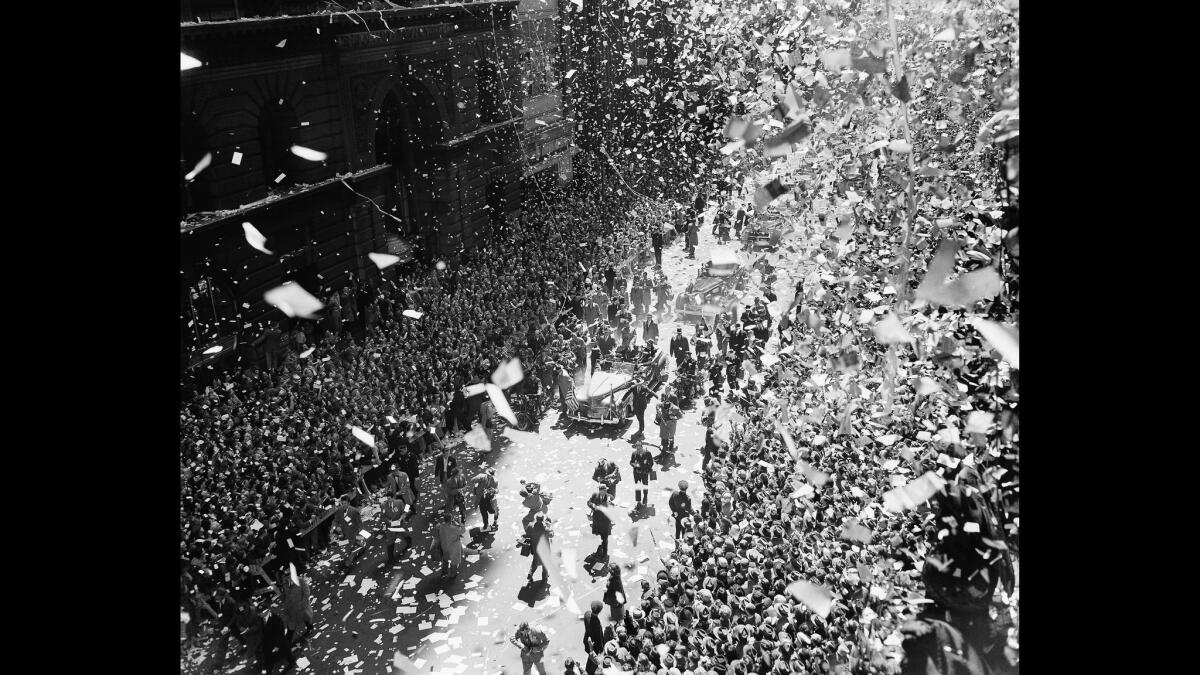Ticker-tape parade for women’s soccer champs part of grand tradition

- Share via
Reporting from New York — Carol Heiss Jenkins, the 1960 Olympic gold medalist in figure skating and one of only a few female athletes to be honored with a New York ticker-tape parade, has advice for members of the U.S. women’s national soccer team, who will be similarly feted Friday.
“Soak it all in,” said Jenkins, 75. “It was a magical experience.”
Jenkins rode up Broadway on March 9, 1960, as fans lining the street cheered and office workers exuberantly threw shredded bits of paper from the windows above.
“Just wow,” she said in a phone interview from Lakewood, Ohio, where she lives. “You look and you think, ‘Oh my, this is awesome.’”
Two hundred and five ticker-tape parades have been held along the stretch of lower Broadway called the Canyon of Heroes since the first one in 1886 marked the dedication of the Statue of Liberty, according to a list compiled by the Alliance for Downtown New York, a business group. The honorees reflect the passions of each era — from military heroes and aviators to astronauts and sports teams.
“Growing up in New York, we’d watch the ticker-tape parades for generals returning from World War II,” Jenkins said. “It was a big thing then and it still is.”
The soccer players, who won the World Cup championship Sunday, join a small, elite group of female athletes so honored. In addition to Jenkins, Althea Gibson, the first African American tennis player to win at Wimbledon, had a parade in 1957 and Gertrude Ederle was honored in 1926 for being the first woman to swim the English Channel.
The gymnast and Olympic gold medalist Mary Lou Retton headlined a ticker-tape parade honoring U.S. medal winners, men and women, from the 1984 Summer Games in Los Angeles, said Kenneth R. Cobb, an assistant commissioner at the city Department of Records and Information Services.
Friday’s parade is significant because it is the first time an all-female athletic team has been chosen as an honoree.
“It is the ultimate symbol of a job well done,” said Cobb, who is the city’s leading expert on ticker-tape parades, having researched and compiled the alliance’s comprehensive list.
Over the years, the nature of who was celebrated with a ticker-tape parade evolved to reflect what was happening in American society, said Cobb. All recipients are chosen by the mayor.
In the early 20th century and through the 1930s, parades often highlighted advances in aviation, he said. Amelia Earhart was feted in 1928 for being the first woman to complete a trans-Atlantic flight. A year later a parade celebrated the crew of the dirigible Graf Zeppelin for the first commercial trans-Atlantic flight.
Things got more political during World War II and the Cold War years, Cobb said. “They started honoring foreign leaders in countries where the U.S. was trying to impress them and keep them from falling into the Soviet sphere,” he said.
During those years, ticker-tape parades happened with great frequency. Ten parades were held in 1951 alone. Among the honorees that year were Galo Plaza Lasso, president of Ecuador; Alcide De Gasperi, prime minister of Italy; and David Ben-Gurion, prime minister of Israel. In 1958 the pianist Van Cliburn rode up Broadway after winning the International Tchaikovsky Competition in Moscow.
The practice of regularly honoring world dignitaries ended with Mayor John Lindsay, who served from 1966 to 1973. Cobb attributed the change to the turbulent political situation in the U.S. during the 1960s, though astronauts continued to be honored, such as the crew of Apollo 11 in 1969.
In later years, only occasional parades have been thrown for world leaders, such as Nelson Mandela in 1990. Since 1999, only five parades have been held, all honoring New York sports teams that had won national championships.
Cobb said the decline in the number of parades reflects the high cost of throwing such a celebration, including providing security for a huge crowd and cleaning up the tons of paper that parades leave in their wakes.
Phil Walzak, a spokesman for Mayor Bill de Blasio, told reporters at City Hall on Wednesday that Friday’s parade would cost $2 million, with approximately $450,000 covered by corporate sponsors. The rest falls to taxpayers.
With the city providing the logistical support for the parade, the Alliance for Downtown New York is making sure there is enough paper to make the occasion festive.
Alliance president Jessica Lappin said that her staff this week contacted management of buildings along the parade route to ask if they had enough recyclable paper for employees to fling from windows.
For buildings that requested additional paper, Lappin said her organization would provide boxes of shredded paper from a confetti company in Brooklyn.
The feeling among organizers is that the achievement of the U.S. women’s soccer team was great enough — and that there was enough public support — to warrant the expense and hassle of organizing a ticker-tape parade.
After the city announced earlier this week that it would host the parade, de Blasio’s wife, Chirlane McCray, tweeted: “The people have spoken & they want a ticker-tape parade to celebrate #USWNT!”
Much is being made of the powerful role models the female soccer players are for younger generations, a point also noted by Jenkins.
“It is wonderful for all women in sports,” she said. “For this team to win with so many goals and to win it so beautifully — I thought they handled everything so well.”
And to get a ticker-tape parade on top of a World Cup championship, Jenkins said, “this is what happens when you’re good at what you do. There are wonderful rewards.”
Haller is a special correspondent.
More to Read
Sign up for Essential California
The most important California stories and recommendations in your inbox every morning.
You may occasionally receive promotional content from the Los Angeles Times.












